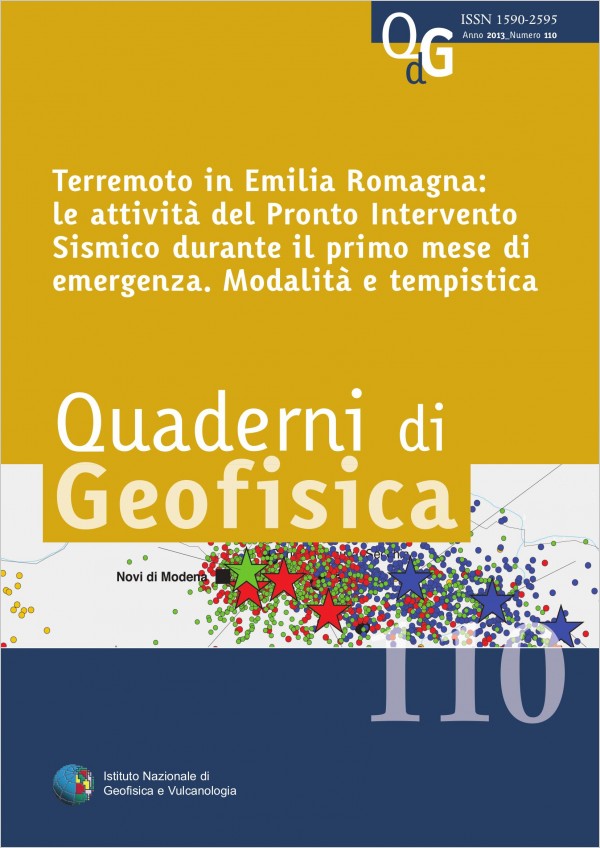Milena Moretti
Istituto Nazionale di Geofisica e Vulcanologia (INGV)
Luigi Abruzzese
Istituto Nazionale di Geofisica e Vulcanologia (INGV)
Paolo Augliera
Istituto Nazionale di Geofisica e Vulcanologia (INGV)
Riccardo Mario Azzara
Istituto Nazionale di Geofisica e Vulcanologia (INGV)
Andrea Bono
Istituto Nazionale di Geofisica e Vulcanologia (INGV)
Paola Bordoni
Istituto Nazionale di Geofisica e Vulcanologia (INGV)
Augusto Bucci
Istituto Nazionale di Geofisica e Vulcanologia (INGV)
Stefano Cacciaguerra
Istituto Nazionale di Geofisica e Vulcanologia (INGV)
Fabrizio Cara
Istituto Nazionale di Geofisica e Vulcanologia (INGV)
Simona Carannante
Istituto Nazionale di Geofisica e Vulcanologia (INGV)
Vincenzo Cardinale
Istituto Nazionale di Geofisica e Vulcanologia (INGV)
Angelo Castagnozzi
Istituto Nazionale di Geofisica e Vulcanologia (INGV)
Marco Cattaneo
Istituto Nazionale di Geofisica e Vulcanologia (INGV)
Adriano Cavaliere
Istituto Nazionale di Geofisica e Vulcanologia (INGV)
Gianpaolo Cecere
Istituto Nazionale di Geofisica e Vulcanologia (INGV)
Claudio Chiarabba
Istituto Nazionale di Geofisica e Vulcanologia (INGV)
Lauro Chiaraluce
Istituto Nazionale di Geofisica e Vulcanologia (INGV)
Maria Grazia Ciaccio
Istituto Nazionale di Geofisica e Vulcanologia (INGV)
Rocco Cogliano
Istituto Nazionale di Geofisica e Vulcanologia (INGV)
Gianfranco Colasanti
Istituto Nazionale di Geofisica e Vulcanologia (INGV)
Marco Colasanti
Istituto Nazionale di Geofisica e Vulcanologia (INGV)
Fabio Criscuoli
Istituto Nazionale di Geofisica e Vulcanologia (INGV)
Giovanna Cultrera
Istituto Nazionale di Geofisica e Vulcanologia (INGV)
Ezio D'Alema
Istituto Nazionale di Geofisica e Vulcanologia (INGV)
Ciriaco D'Ambrosio
Istituto Nazionale di Geofisica e Vulcanologia (INGV)
Stefania Danesi
Istituto Nazionale di Geofisica e Vulcanologia (INGV)
Pasquale De Gori
Istituto Nazionale di Geofisica e Vulcanologia (INGV)
Giovanni De Luca
Istituto Nazionale di Geofisica e Vulcanologia (INGV)
Alberto Delladio
Istituto Nazionale di Geofisica e Vulcanologia (INGV)
Martina Demartin
Istituto Nazionale di Geofisica e Vulcanologia (INGV)
Giuseppe Di Giulio
Istituto Nazionale di Geofisica e Vulcanologia (INGV)
Emanuela Ercolani
Istituto Nazionale di Geofisica e Vulcanologia (INGV)
Licia Faenza
Istituto Nazionale di Geofisica e Vulcanologia (INGV)
Luigi Falco
Istituto Nazionale di Geofisica e Vulcanologia (INGV)
Pietro Ficeli
Istituto Nazionale di Geofisica e Vulcanologia (INGV)
Antonio Fodarella
Istituto Nazionale di Geofisica e Vulcanologia (INGV)
Diego Franceschi
Istituto Nazionale di Geofisica e Vulcanologia (INGV)
Gianlorenzo Franceschina
Istituto Nazionale di Geofisica e Vulcanologia (INGV)
Massimo Frapiccini
Istituto Nazionale di Geofisica e Vulcanologia (INGV)
Lucian Giovani
Istituto Nazionale di Geofisica e Vulcanologia (INGV)
Aladino Govoni
Istituto Nazionale di Oceanografia e di Geofisica Sperimentale (OGS)
Luigi Improta
Istituto Nazionale di Geofisica e Vulcanologia (INGV)
Chiara Ladina
Istituto Nazionale di Geofisica e Vulcanologia (INGV)
Valentino Lauciani
Istituto Nazionale di Geofisica e Vulcanologia (INGV)
Barbara Lolli
Istituto Nazionale di Geofisica e Vulcanologia (INGV)
Sara Lovati
Istituto Nazionale di Geofisica e Vulcanologia (INGV)
Francesco Pio Lucente
Istituto Nazionale di Geofisica e Vulcanologia (INGV)
Lucia Luzi
Istituto Nazionale di Geofisica e Vulcanologia (INGV)
Alfonso Giovanni Mandiello
Istituto Nazionale di Geofisica e Vulcanologia (INGV)
Carlo Marcocci
Istituto Nazionale di Geofisica e Vulcanologia (INGV)
Lucia Margheriti
Istituto Nazionale di Geofisica e Vulcanologia (INGV)
Simone Marzorati
Istituto Nazionale di Geofisica e Vulcanologia (INGV)
Marco Massa
Istituto Nazionale di Geofisica e Vulcanologia (INGV)
Salvatore Mazza
Istituto Nazionale di Geofisica e Vulcanologia (INGV)
Giuliano Milana
Istituto Nazionale di Geofisica e Vulcanologia (INGV)
Felice Minichiello
Istituto Nazionale di Geofisica e Vulcanologia (INGV)
Giancarlo Monachesi
Istituto Nazionale di Geofisica e Vulcanologia (INGV)
Andrea Morelli
Istituto Nazionale di Geofisica e Vulcanologia (INGV)
Raffaele Moschillo
Istituto Nazionale di Geofisica e Vulcanologia (INGV)
Francesca Pacor
Istituto Nazionale di Geofisica e Vulcanologia (INGV)
Davide Piccinini
Istituto Nazionale di Geofisica e Vulcanologia (INGV)
Ulderico Piccolini
Istituto Nazionale di Geofisica e Vulcanologia (INGV)
Maurizio Pignone
Istituto Nazionale di Geofisica e Vulcanologia (INGV)
Stefano Pintore
Istituto Nazionale di Geofisica e Vulcanologia (INGV)
Silvia Pondrelli
Istituto Nazionale di Geofisica e Vulcanologia (INGV)
Stefania Pucillo
Istituto Nazionale di Geofisica e Vulcanologia (INGV)
Matteo Quintiliani
Istituto Nazionale di Geofisica e Vulcanologia (INGV)
Gaetano Riccio
Istituto Nazionale di Geofisica e Vulcanologia (INGV)
Simone Salimbeni
Istituto Nazionale di Geofisica e Vulcanologia (INGV)
Laura Sandri
Istituto Nazionale di Geofisica e Vulcanologia (INGV)
Giulio Selvaggi
Istituto Nazionale di Geofisica e Vulcanologia (INGV)
Andrea Serratore
Istituto Nazionale di Geofisica e Vulcanologia (INGV)
Marcello Silvestri
Istituto Nazionale di Geofisica e Vulcanologia (INGV)
Luisa Valoroso
Istituto Nazionale di Geofisica e Vulcanologia (INGV)
Gianfranco Vannucci
Consiglio Nazionale delle Ricerche (CNR)
Lucia Zaccarelli
Istituto Nazionale di Geofisica e Vulcanologia (INGV)
Abstract
On May 20th 2012 (Sunday) an earthquake (ML 5.9) hit Northern Italy at 02:03 UTC,. The National Seismic Network [Amato and Mele, 2008; Delladio, 2011] of the Istituto Nazionale di Geofisica e Vulcanologia (INGV) located the hypocenter below the Po Valley in the Emilia region (44.89° N, 11.23° E, 6.3 km depth). Just after the mainshock, the INGV structure of rapid response for seismic emergency has been activated in order to install a temporary seismic network as a complementary of existing permanent network in the epicentral area. The INGV installed 44 temporary stations, ten of these transmitting in real time to seismic monitoring room in Rome. Further 38 temporary seismic stations (16 provided by National Civil Protection Department - DPC, 8 provided by the National Institute of Oceanography and Experimental Geophysics - OGS and 14 provided by French colleagues) have been installed in the epicentral area. The final configuration was obtained by coordination among INGV and other agencies. The Centro Operativo Emergenza Sismica (COES) [Moretti et al., 2010a] was activated relatively late, on June 8th 2012, because the INGV branch in Bologna located close to the epicentral area, was in the early days fulfilling the COES tasks. The COES ensured continuous and direct communication with the DPC officers present in the epicentral area. At the same time, the structure has been proposed as logistic support to all the INGV colleagues engaged in activities in the epicentral area (mobile seismic networks, EMERSITO, GPS, EMERGEO, QUEST) and to the service dedicated to the education and information promoted in favor of affected populations, civil defense operators as well as rescue volunteers. In this paper we will describe the activities carried out during the first month of emergency, the method and timing of the intervention, and finally the structures involved.


